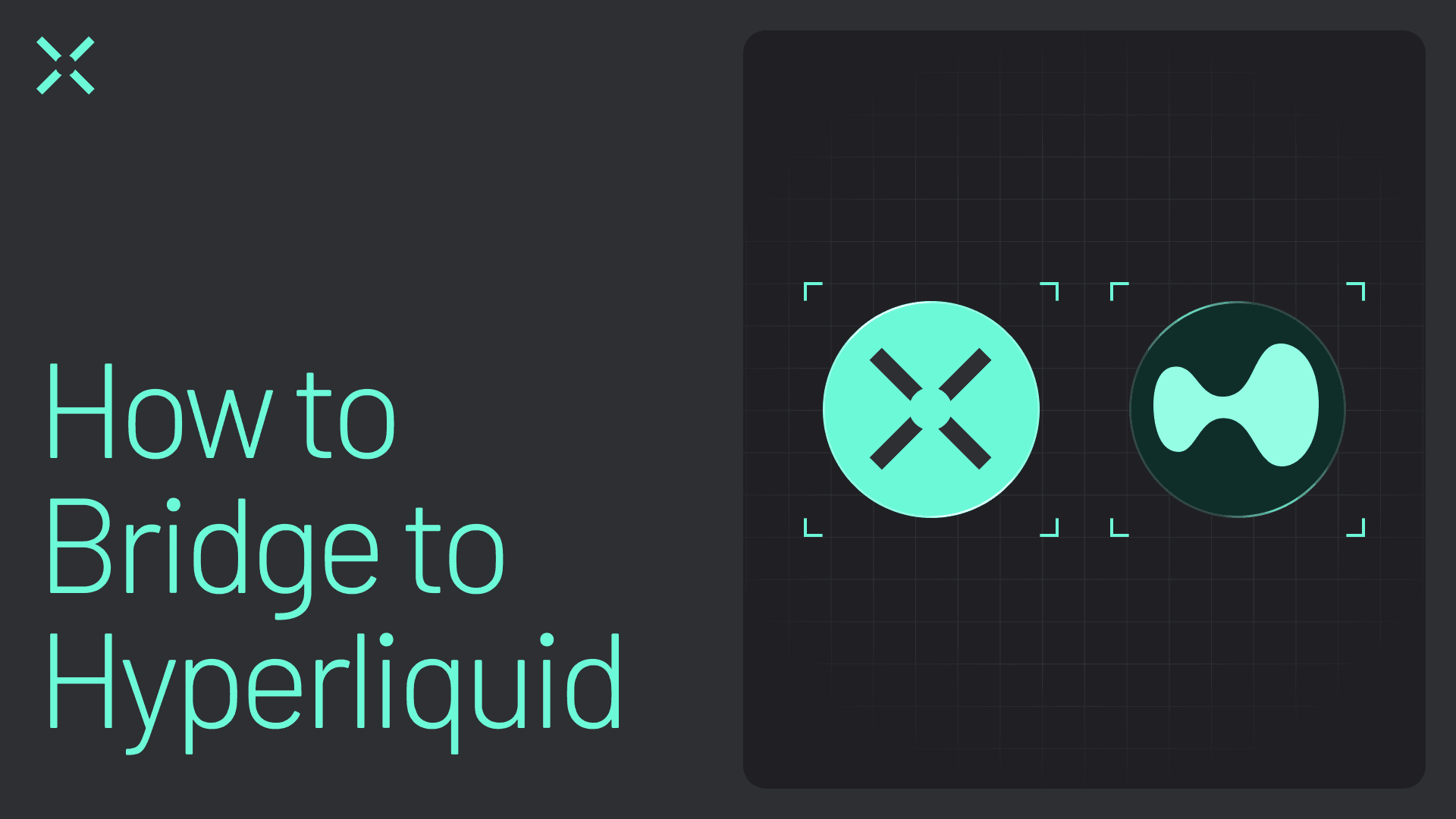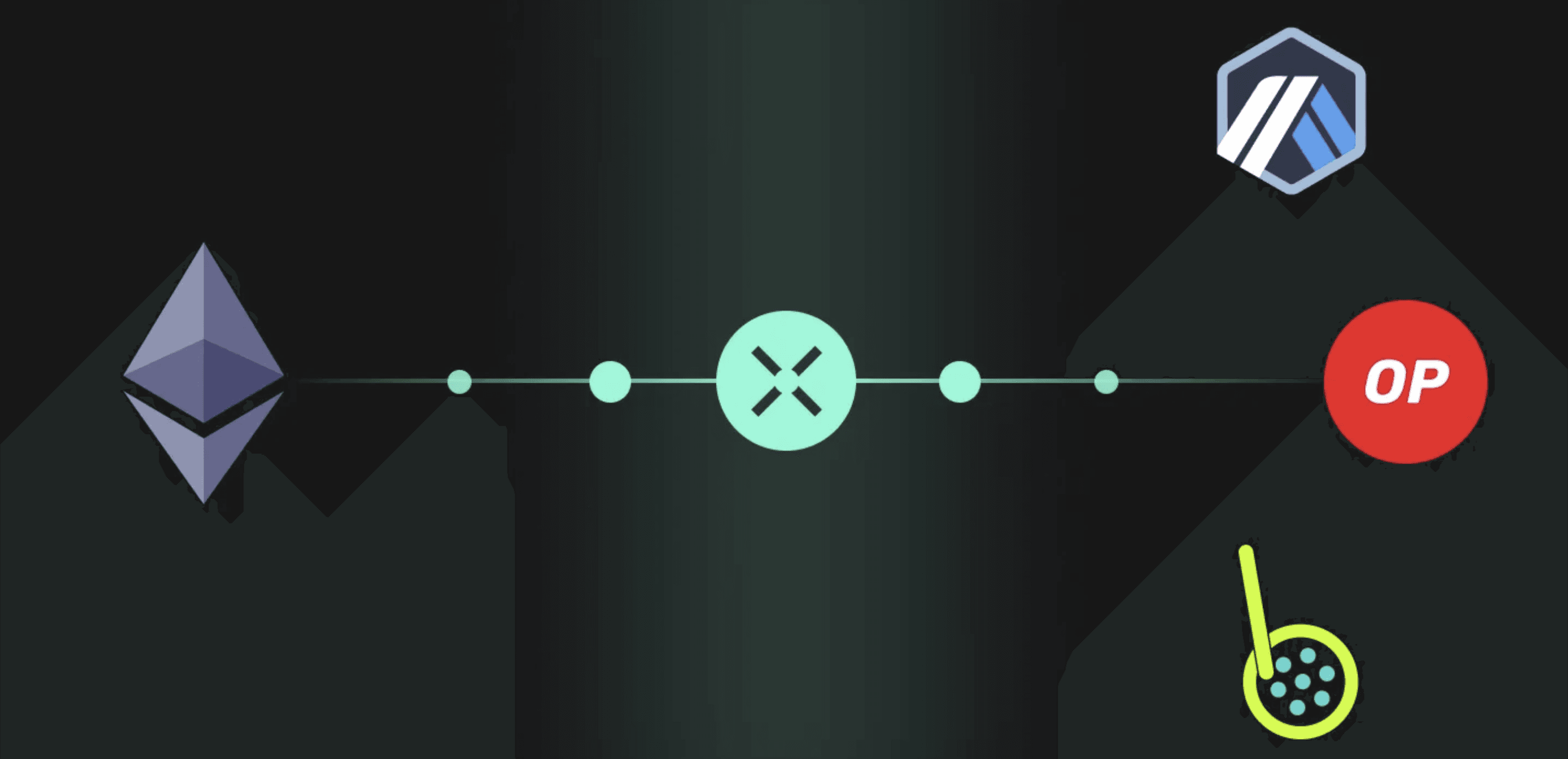Introduction: The Need for a Better Hyperliquid Bridge
Hyperliquid is one of the fastest-growing decentralized exchanges (DEXs) in DeFi, offering a fully onchain order book, low-latency execution, and gasless trading for token perpetuals (perps). But before you can trade, you need to get funds onto the network.
Many traders use Hyperliquid’s native Arbitrum bridge, but it’s slower, limited in route support, and often involves extra steps before you can start trading. That’s where Across Protocol comes in.
Across is crypto's fast, cheap, and secure bridge, powered by intents. Driving over $27.5B in volume and 17.3M transfers for over 4 million users across 20 supported blockchains, Across is battle-tested and built for high-speed trading. In this guide, we’ll show you exactly how to use Across to bridge to Hyperliquid faster, cheaper, and without the headaches.
What Is Hyperliquid?
Hyperliquid is a perp DEX application built on HyperEVM: a Layer 1 appchain designed for professional and retail DeFi traders. Every element of its architecture is engineered for high throughput, low latency, and total transparency, without sacrificing decentralization. Trades clear instantly, liquidity is visible in real time, and onboarding is designed to be as frictionless as possible.
The Hyperliquid DEX regularly ranks among the most active onchain derivatives platforms, As of August 2025, the platform has processed over $67 billion in volume, secures more than $597 million in TVL, and supports a rapidly growing user base.

Hyperliquid has quickly become one of DeFi’s most popular perp DEXs.
Hyperliquid DEX vs. HyperEVM
Hyperliquid DEX:
Perp DEX app built on the HyperEVM.
Pairs HyperEVM’s high-performance backend with a clean, intuitive frontend. Traders get advanced charting, analytics, and order management tools in a seamless browser-based interface, making it easy to switch between markets, monitor positions, and execute complex strategies.
Features include a fully onchain order book for perpetual futures, gasless permit signatures so you can deposit without paying extra fees, and secure routing via Arbitrum to ensure your bridge transactions are protected from start to finish.
Users can trade with order types including TWAP and scale orders, plus competitive funding rates. And it all happens in an ecosystem where every detail serves one goal: making trading faster, cheaper, and more transparent.
Hyper EVM:
EVM-compatible L1 blockchain build for trading.
The network runs on HyperBFT, a Tendermint-inspired consensus algorithm tuned for speed, and a full-stack optimizable design that allows continuous performance improvements.
Bridging Limitations: The Problem with Native and Third‑Party Hyperliquid Bridges
When it comes to getting funds onto Hyperliquid, traders often face a choice: use the native Arbitrum bridge or a third-party bridging solution. The Arbitrum bridge is a reliable option; However, it requires several minutes to complete a transfer and supports only a single route. This means traders starting from other chains must take multiple steps and potentially make extra swaps before they can begin trading.
Other third‑party bridges introduce risks associated with wrapped tokens, mint and burn mechanics, liquidity pools, and validator sets. Users often suffer from higher fees, longer wait times, smart contract security vulnerabilities, or complex routing that adds unnecessary steps. For active traders, these bottlenecks can mean missed opportunities.
Across eliminates these pain points with near‑instant fills, native USDC delivery from 20+ chains, and a secure intent-based architecture. It is purpose‑built to get funds onto Hyperliquid quickly, securely, and without friction, so you can start trading immediately.
Why Traders Bridge to Hyperliquid with Across Protocol
When trading crypto, speed matters. That's why traders rely on Across Protocol to send USDC to Hyperliquid as quickly as possible.
Across offers:
Near-instant bridge times: as fast as 2 seconds for L2 → Hyperliquid routes.
Ultra-low fees: most transfers under $1, even at high volume.
Direct USDC deposits: from 15+ chains without extra steps.
Intents-based architecture: every transfer is secured by UMA.
Zero security exploits: since launch.
Direct bridging: to the Hyperliquid trading app.
Popular bridge routes include:
Across’ Hyperliquid integration empowers traders to fund their accounts in seconds and start trading immediately. No waiting, no complexity, no extra conversions.
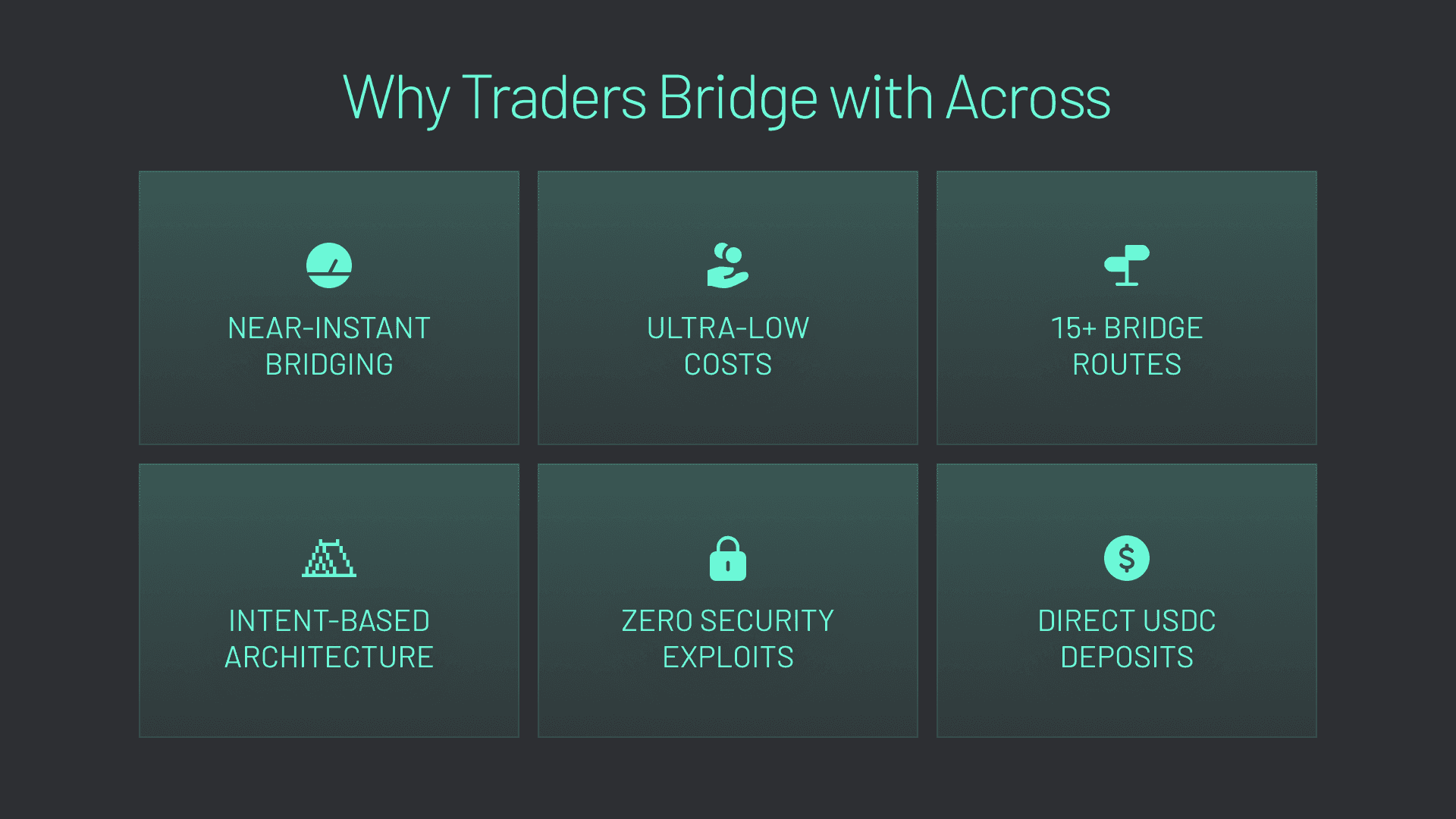
Traders love to bridge to Hyperliquid with Across.
Step-by-Step: How to Bridge to Hyperliquid with Across Protocol
Across Protocol powers fast, cheap, and secure USDC bridging directly to the Hyperliquid trading app. Here is the full process:
1. Go to the Across Bridge App
Navigate to app.across.to.
2. Connect Your Wallet
Use MetaMask or another EVM wallet to complete your wallet connection.

Step 2: Connect your wallet.
3. Select USDC + Your Origin Chain
Pick USDC as your token and choose the chain you’re bridging from. In this example, we are bridging from Base to Hyperliquid.
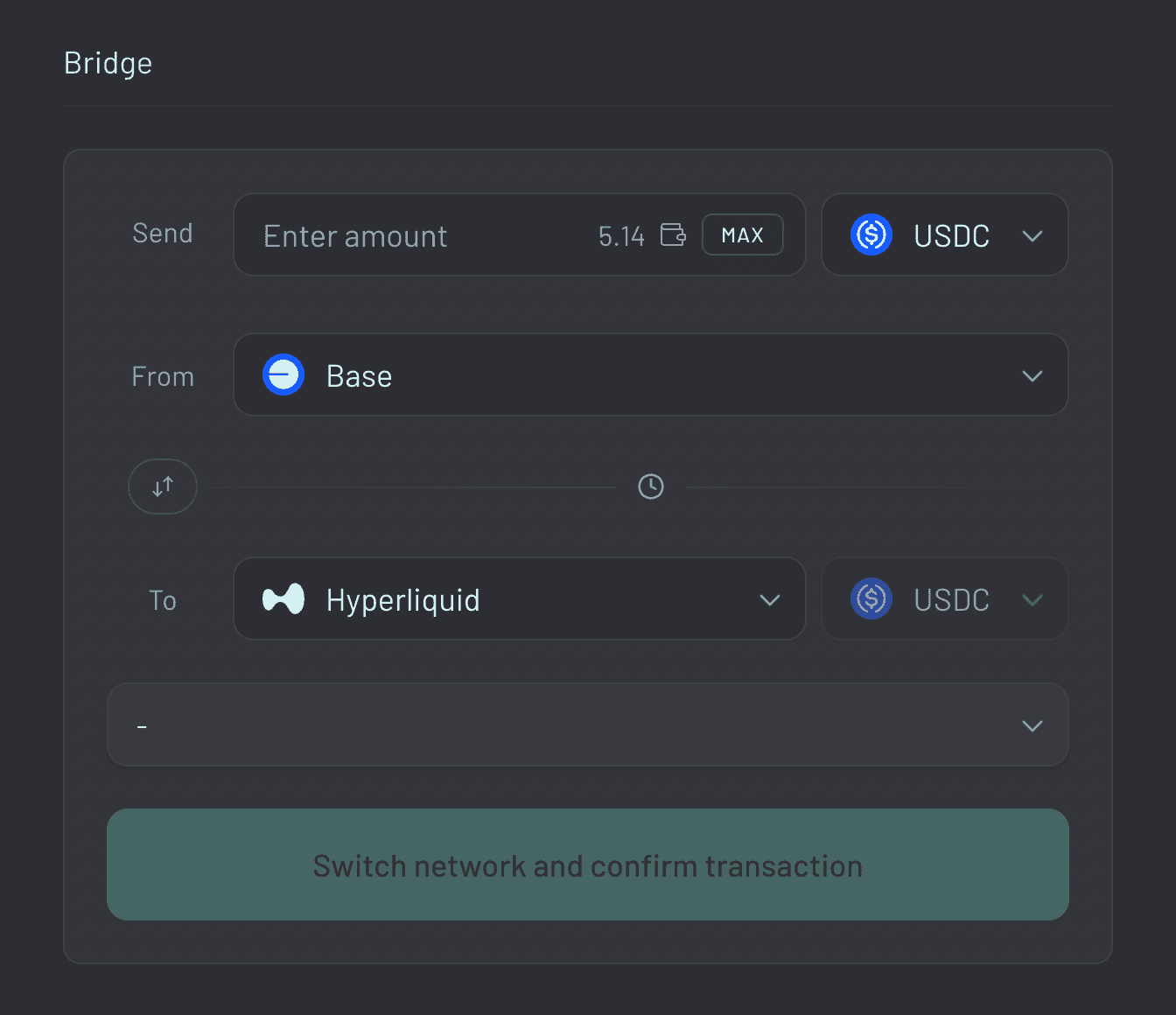
Step 3: Select USDC and your origin chain.
4. Choose Hyperliquid as the Destination Chain
Across relayers will route through Arbitrum automatically.
5. Enter the Amount You Want to Bridge
Input the amount of USDC you want to bridge to Hyperliquid.
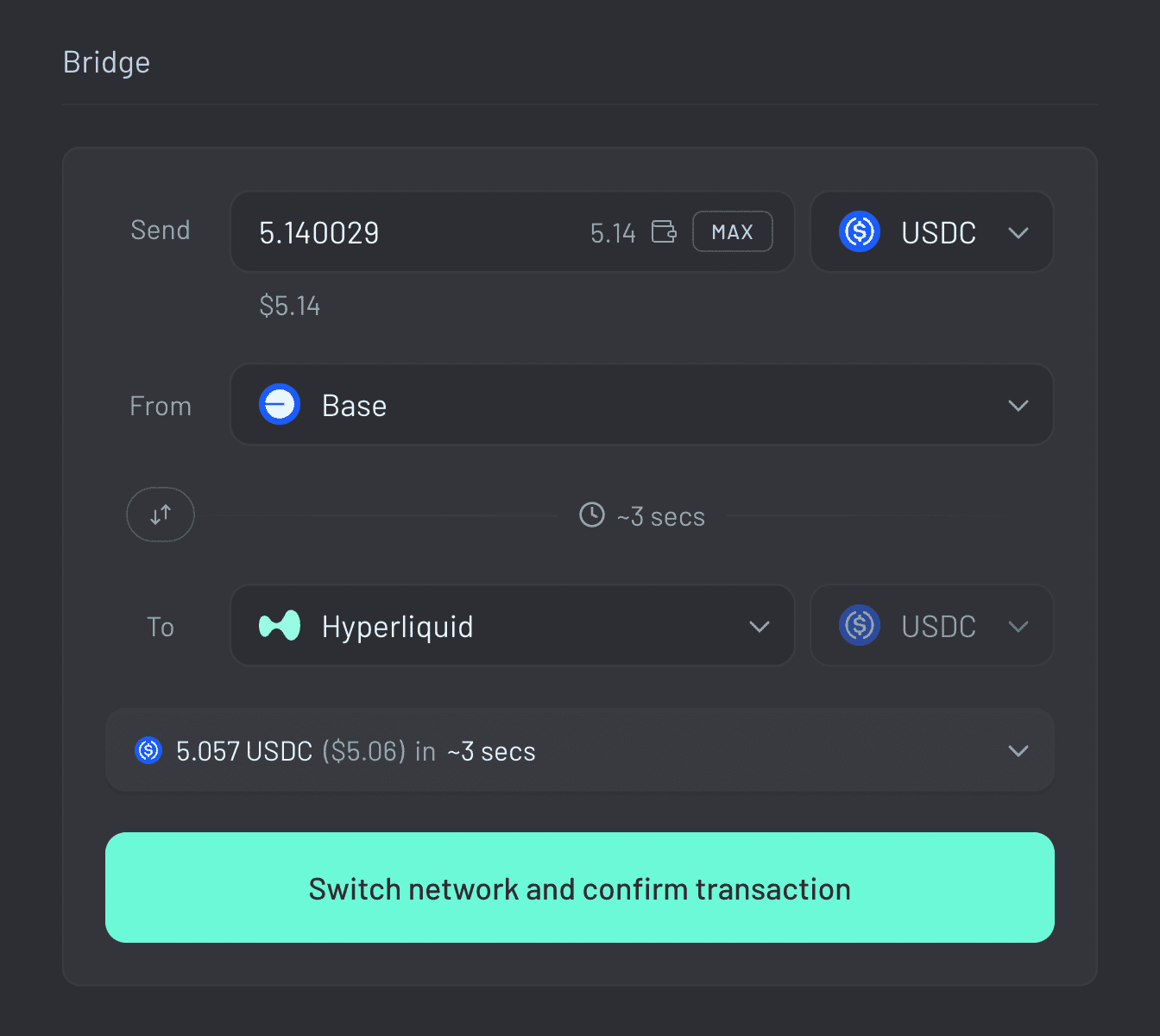
Step 5: Enter the amount of $USDC you want to bridge.
6. Review Fees & Timing
Check the gas costs, fees, and other estimated transaction details.
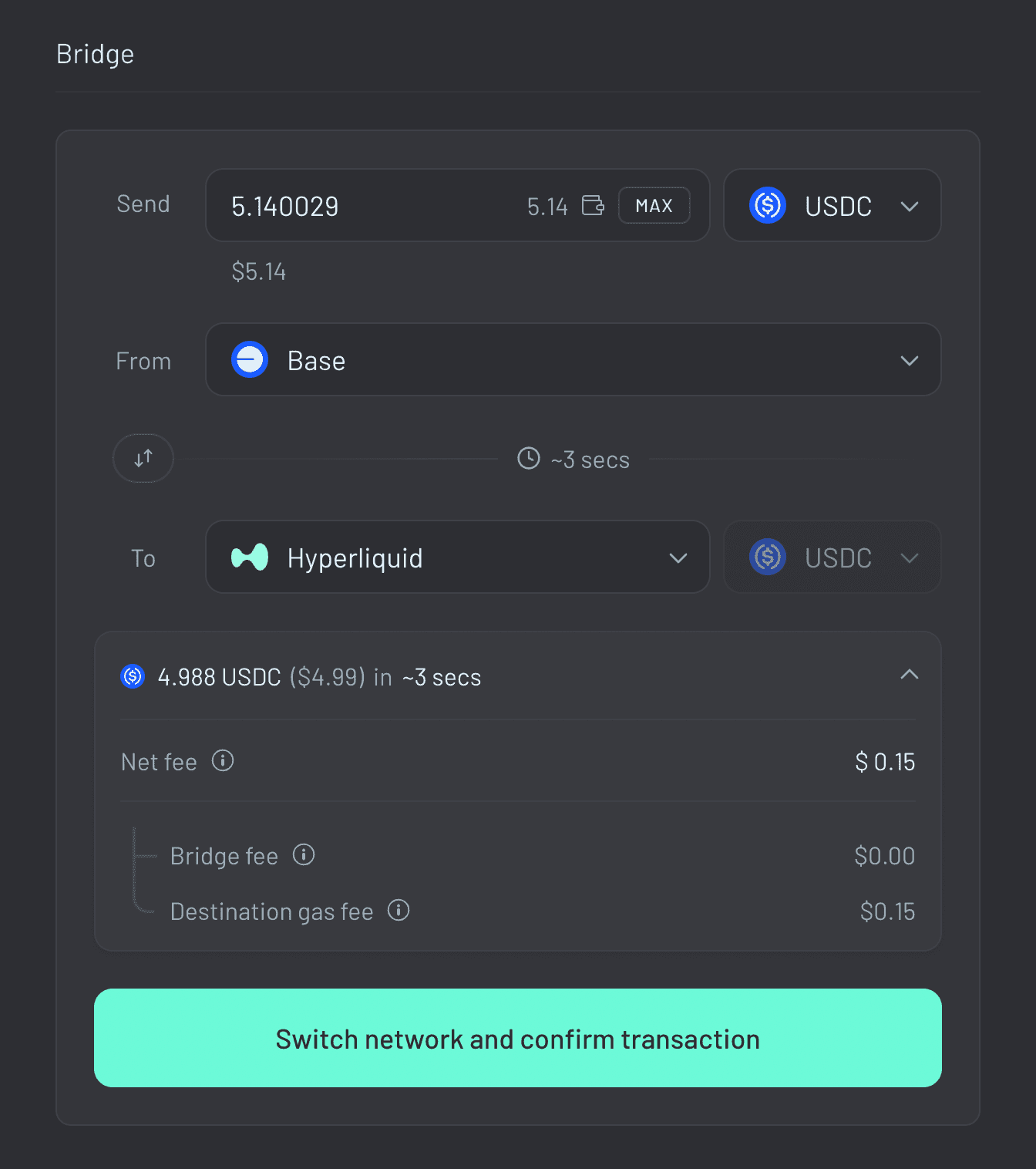
Step 6: Review fees and timing.
7. Confirm the Transaction
Click the “Confirm transaction” button, then sign and confirm the transaction in your wallet.
Note: If your wallet isn’t already connected to the Arbitrum network, the button will say “Switch network and confirm transaction”. Simply click it and follow the flow.
8. Receive Your USDC on Hypeliquid
Your USDC will arrive on Hyperliquid in seconds. They will be visible in your Hyperliquid balance.
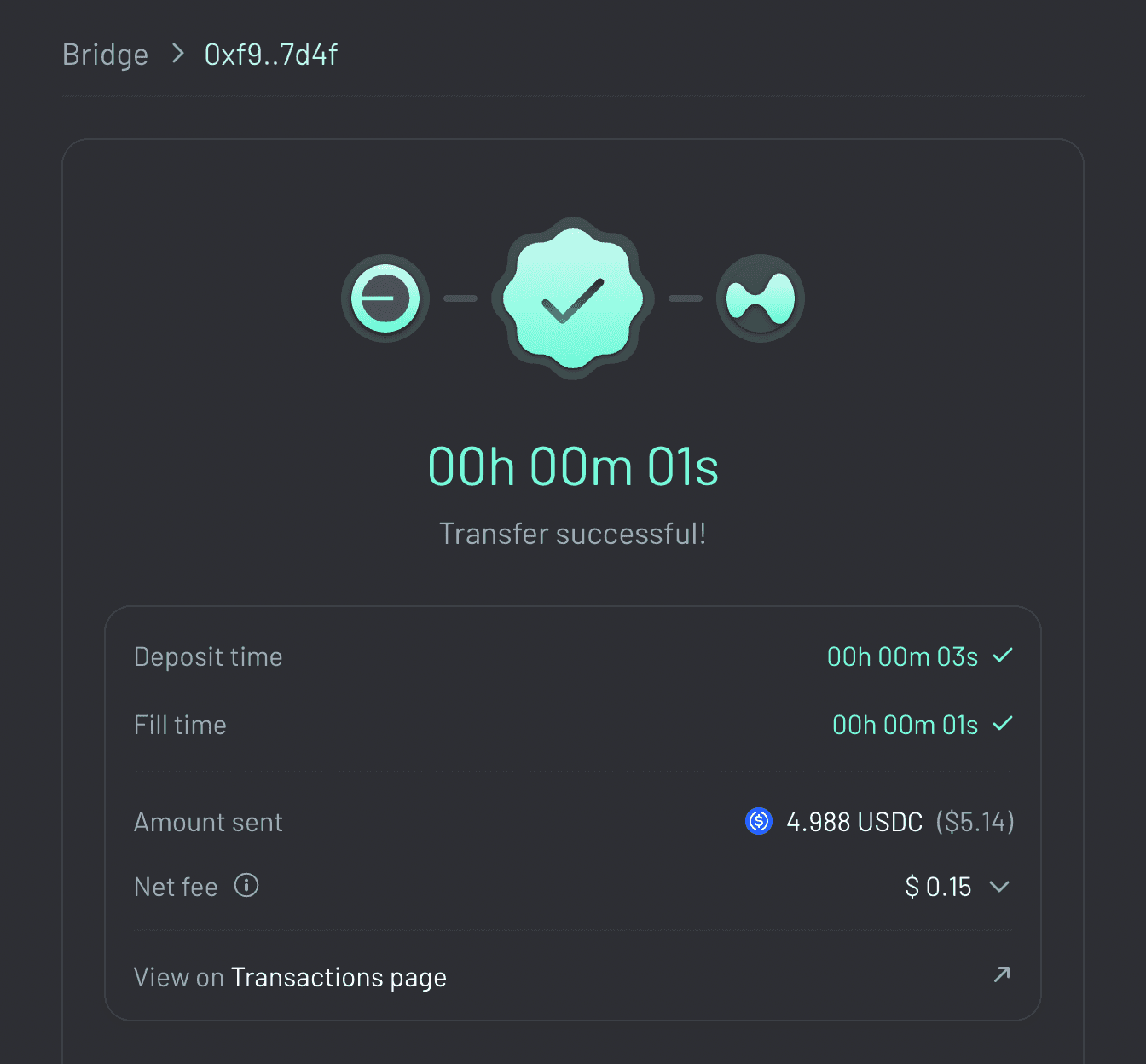
Step 8: Receive your USDC on Hyperliquid in seconds.
This process takes only seconds, and bridging happens near-instantly. If you are a technical user, you can track your transfer on Arbiscan (the Arbitrum mainnet explorer).
Comparing Across to Hyperliquid’s Native Arbitrum Bridge
How does the native Arbitrum bridge compare to Across? While the native option works, it’s limited in speed and route support, which can slow you down. The table below breaks down how Across stacks up against Hyperliquid’s native Arbitrum bridge so you can choose the fastest, most efficient path.
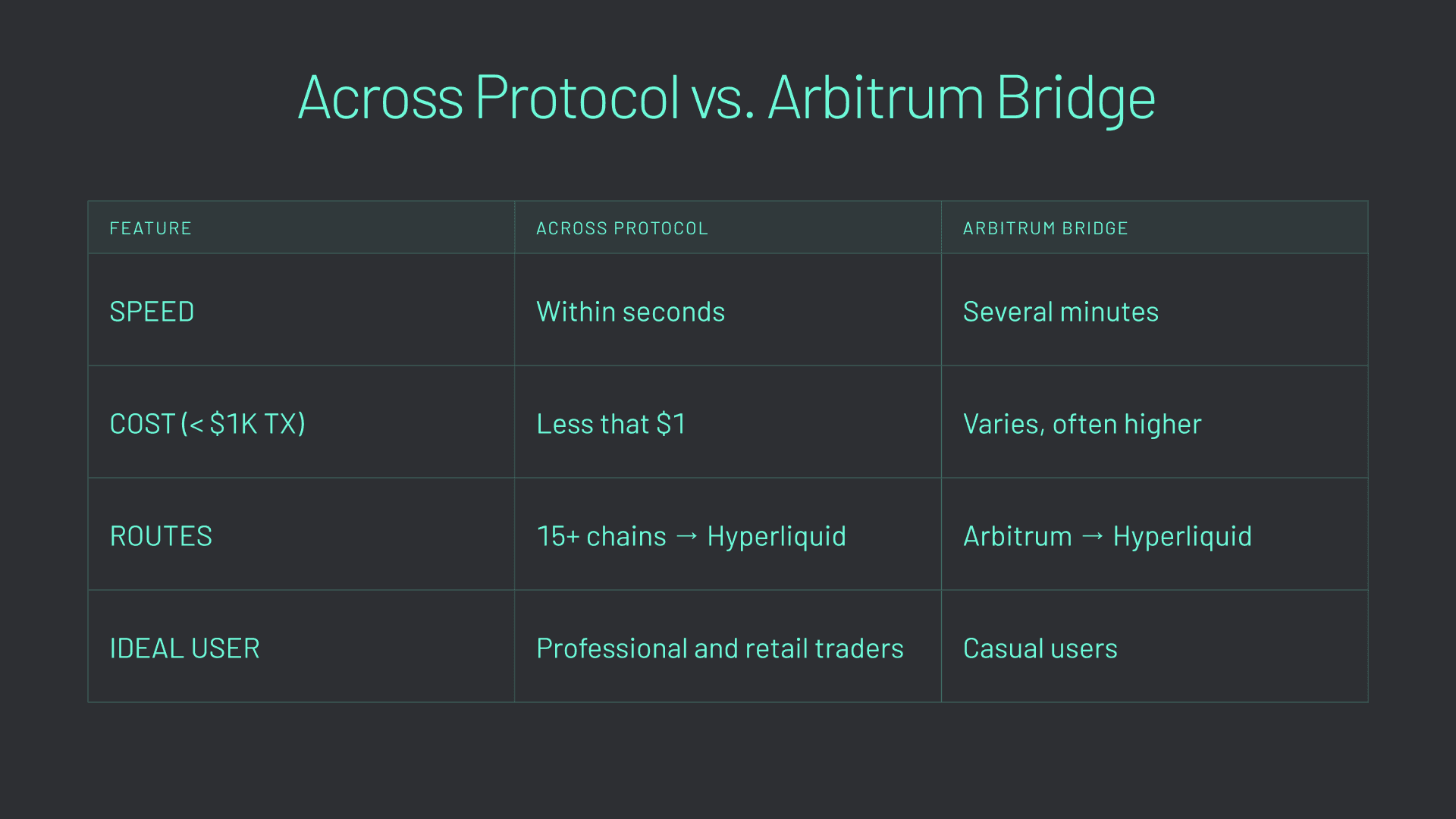
Across Protocol vs. Arbitrum Bridge.
Across Protocol: The Trader’s Gateway to Hyperliquid
Across is one of crypto’s most battle-tested and widely used bridges. Since launch, it has moved over $27.5 billion in value across chains, powering over 17.3 million transfers and trusted by more than 4 million unique users.
With 20+ supported blockchains (and counting!), Across connects the heart of Ethereum’s L2 ecosystem with alternative L1s, delivering unmatched reach for traders and builders alike. Transfers are lightning fast, filling in just 2 seconds on average for L2 → L2 routes while costs stay consistently low, with most transactions costing less than $1. Additionally, Across has incurred zero security exploits since its launch, providing users with the peace of mind they deserve when transferring tokens across blockchain ecosystems.
The secret: intent-based architecture. Intents empower traders to simply state their end-goal (e.g., bridge USDC from Base to Hyperliquid) while the system handles all the complexity under the hood in a decentralized and secure manner. The result? You receive your funds on Hyperliquid in seconds for cents without taking on any functionality risk.
It’s this careful combination of speed, cost-efficiency, and security that makes Across the go-to bridge for Hyperliquid traders who want to trade perpetuals and spot pairs instantly.
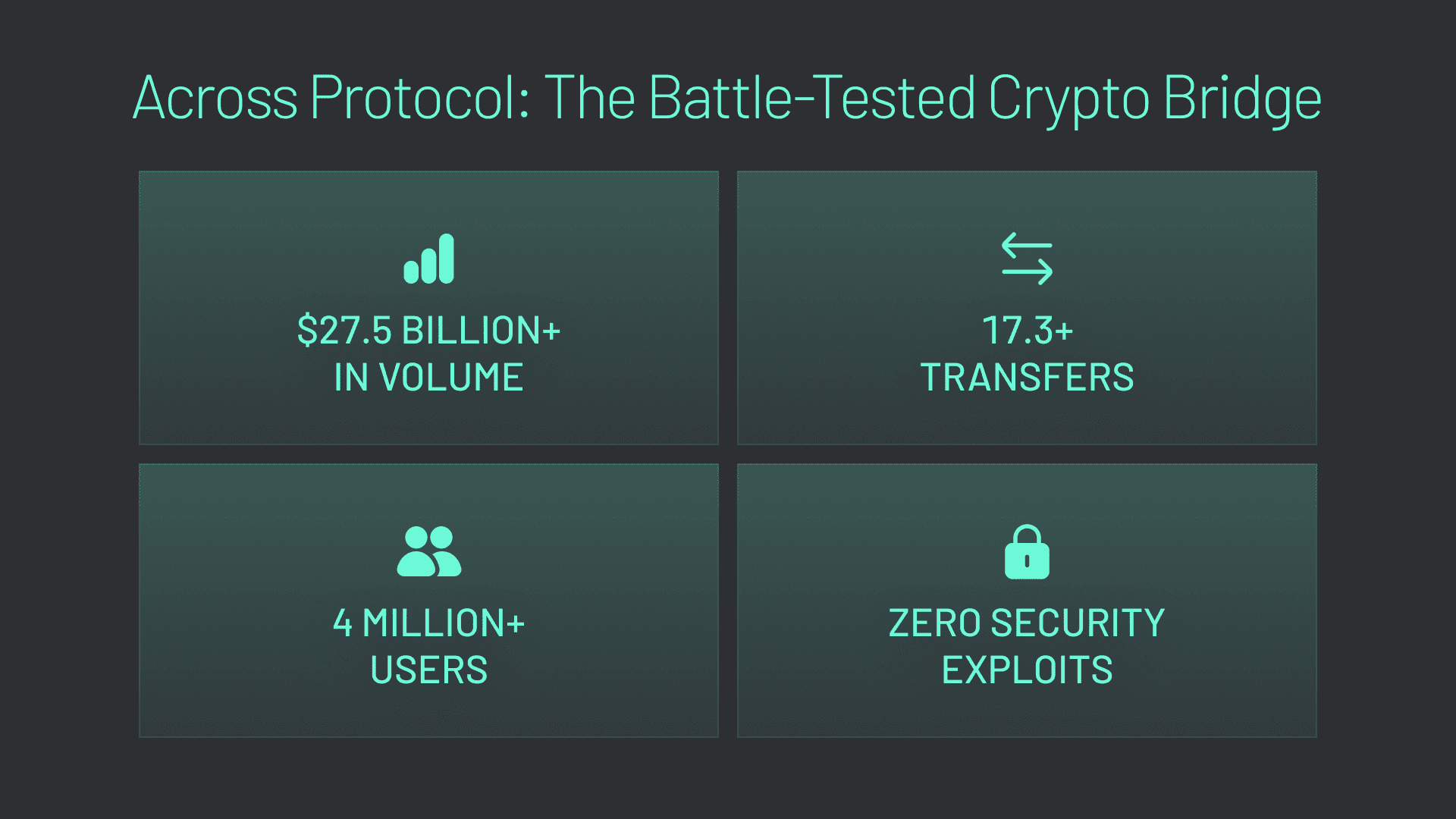
Across Protocol is the battle-tested crypto bridge.
Before You Bridge to Hyperliquid: Wallet Setup, Gas, and More
Getting started on Hyperliquid is quick and intuitive. But before you bridge to Hyperliquid with Across, here are a few things you should do to ensure the best possible trading experience:
Create an EVM-Compatible Wallet: Hyperliquid uses your EVM-compatible wallet (e.g., MetaMask, Trust Wallet, and Phantom) as your account. Simply create your wallet and connect it with the Hyperliquid app. No email or KYC required.
Acquire ETH for Gas: Make sure you fund your wallet with ETH on the origin chain. This ensures you have enough gas to send funds to the network.
Understand Hyperliquid and the HyperEVM Ecosystem: Hyperliquid is a perp DEX trading application that runs on the HyperEVM L1 blockchain. In addition to massive trading opportunities, there are also staking programs available, allowing you to earn rewards via the HLP vault. The more you understand the intermechanics of the ecosystem, the more equipped you will be to succeed.
Access the Across app: Visit https://app.across.to and connect your wallet to start bridging. Follow the step-by-step process above to bridge your funds successfully.
Security You Can Trust: Why Across Protocol is Built for Secure, High-Frequency Transfers
When you bridge to Hyperliquid, you’re trusting the infrastructure that moves your assets. Across Protocol is built with security as a first principle. Every transaction is secured by UMA: a decentralized verification layer that ensures transfers are valid before settlement.
Unlike bridges that rely on custodial multisigs or vulnerable validator sets, Across uses an intents-based architecture with independent relayers competing to fill your transfer. If a dispute arises, UMA steps in to resolve it. This creates a trust-minimized, tamper-resistant process.
The result is a bridging experience that’s not only fast and cheap, but also provably secure.
Withdrawing from Hyperliquid
Currently, Across supports bridging into Hyperliquid, but not out of it. If you need to withdraw your funds from Hyperliquid back to another chain, you’ll need to use Hyperliquid’s native withdrawal flow. To do this, navigate to the Hyperliquid DEX app and simply click the “Withdraw” button located under the “Deposit” button.
Withdrawals on Hyperliquid use an EIP-712 compliant typed message signing process. Specifically, the withdrawal request is signed by your wallet according to the EIP-712 domain rules. This signature is then verified by Hyperliquid before the withdrawal is processed.
For more support, you can read the official documentation from Hyperliquid and the Ethereum Foundation here:
Bridge & Withdrawals Overview: Hyperliquid Bridge Docs
EIP-712 Specification: EIP-712 Ethereum Improvement Proposal
Once Across supports HL withdrawals, you’ll be able to use the same fast, low-cost, and secure bridging you get when depositing. Until then, Hyperliquid’s native process is the way to go for withdrawals.
Conclusion
Hyperliquid is redefining what’s possible in onchain trading, and Across provides the way to get there. Whether you’re looking to capture the next 10x opportunity, test the waters with a small deposit, or move serious capital with confidence, Across gets your funds onto Hyperliquid safely in seconds, for cents. No unnecessary swaps, no inflated fees, no waiting around while the market moves without you.
With billions bridged, millions of transactions processed, and a track record of reliability, Across is the trading edge you’ve been looking for. The next time you see an opportunity on Hyperliquid, you won’t just watch it happen. You’ll be there before everyone else.
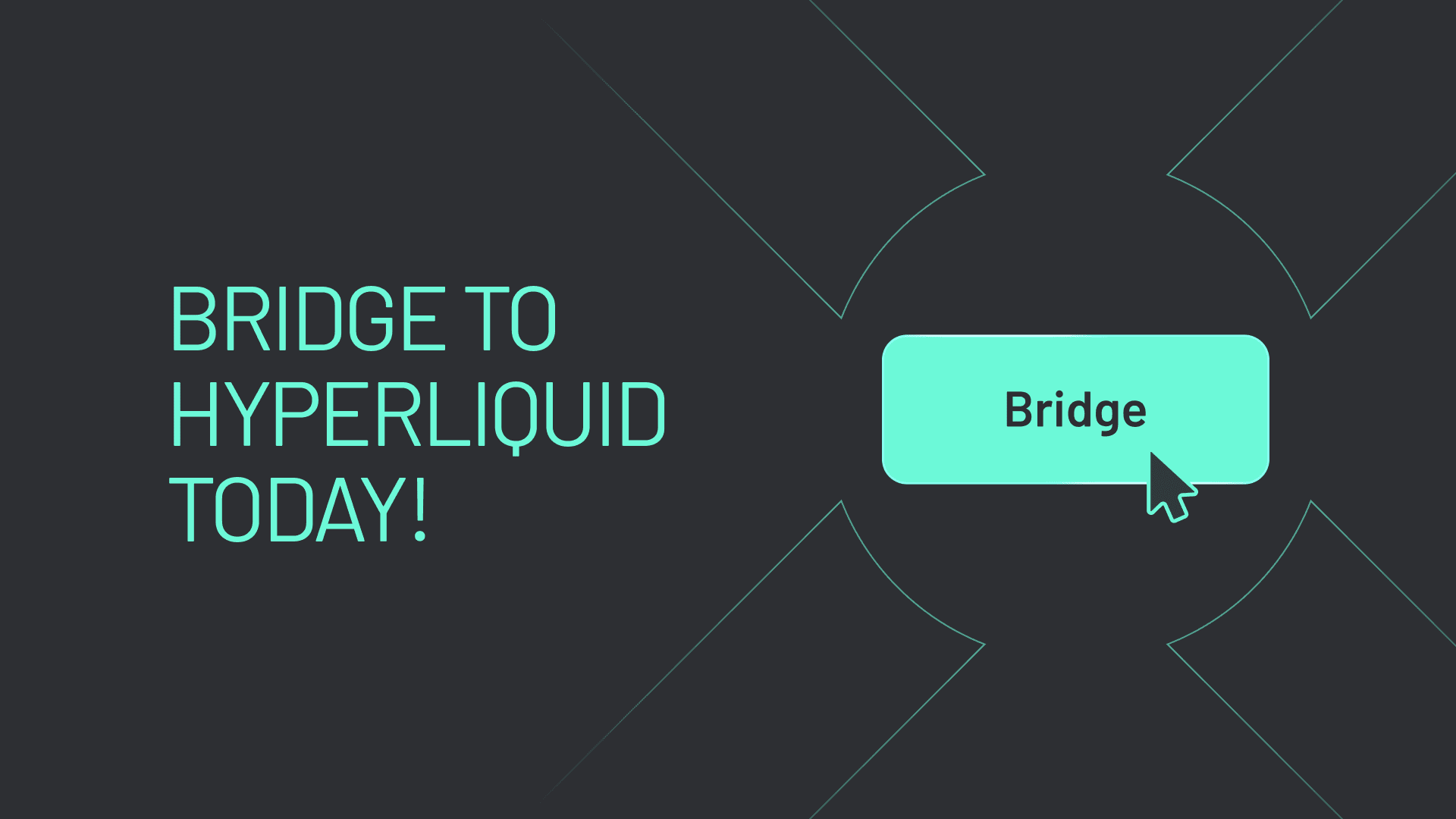
Bridge to Hyperliquid now with Across Protocol.
FAQ
What assets can I bridge to Hyperliquid with Across?
Across currently supports USDC bridging to Hyperliquid from 15+ supported chains. Once on Hyperliquid, you can trade a wide range of perpetual and spot markets.
How fast will my funds arrive?
For most L2 → Hyperliquid transfers, your USDC will arrive in as little as 2 seconds. L1 → Hyperliquid routes typically finalize in about 10 seconds.
How much does it cost?
Most transfers under $1,000 cost less than $1 in total fees. Even large transfers remain competitively priced compared to other bridges.
Do I need ETH for gas?
Yes, but only on the origin chain. Once your funds are on Hyperliquid, trading is completely gasless thanks to permit signatures.
Is the Across flow gas-efficient?
Yes. Across minimizes total transaction costs by delivering native USDC directly to Hyperliquid without unnecessary swaps, wrapping, or intermediate hops.
Is Across safe to use?
Yes. Across employs a decentralized relayer network to ensure reliability and uses UMA to secure transactions before they settle onchain. It also uses canonical asset bridging, meaning you always receive native USDC. No risky wrapped tokens.
Can I bridge out of Hyperliquid with Across?
Not yet. Across currently supports inbound bridging to Hyperliquid. For withdrawals, you’ll need to use the Arbitrum Bridge or other supported methods.
How does Across compare to the native Arbitrum bridge?
Across offers faster settlement, support for more source chains, lower fees on most routes, and eliminates the need for multiple swaps. The native bridge is functional, but it’s slower and more limited in flexibility.
Join the Across community:

